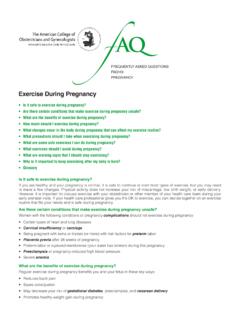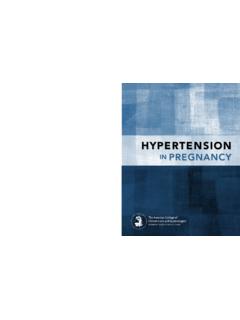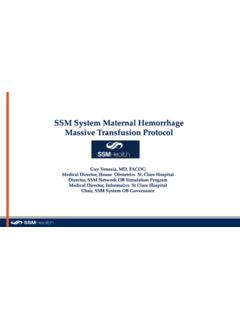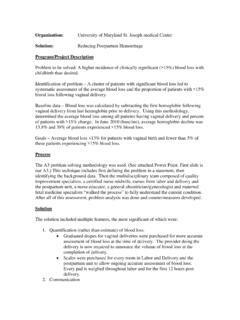Transcription of The AIM Malawi Program – Innovation in Maternal Health
1 Pg. 1 The AIM Malawi Program Innovation in Maternal Health Demonstration Project to Tailor a Maternal Health Quality Improvement Program in a Low-Resource Setting Executive Summary December 2017 The American College of Obstetricians and Gynecologists (ACOG), Baylor College of Medicine/Texas Children s Hospital (BCM) and the Malawi Ministry of Health (MOH) have collaborated to implement the Alliance for Innovation in Maternal Health in Malawi Program (AIM Malawi ). AIM Malawi is a modification of the AIM Program that has successfully reduced Maternal mortality and severe morbidity in the United Results of the 18-month demonstration project show that the Program has been effectively implemented in three facilities in Lilongwe, reducing the incidence of Maternal hemorrhage, increasing the use of life-saving interventions, improving team-based care and referral networks and increasing a culture of safety for Maternal Health care.
2 Innovation in Maternal Health Care: The AIM Approach AIM is an integrated, multi-disciplinary approach to improving Maternal safety through a commonly shared data-driven quality improvement process and evidence-based implementation resources to streamline Maternal safety bundle implementation. AIM supports: Development of a common work culture that fosters communication, team building, team function, multi-disciplinary collaboration and leadership among all Health care providers through drills, simulations, and team training. Implementation of standardized protocols and checklists within maternity facilities to recognize, treat and prevent obstetrical emergencies.
3 1 For more information on AIM, please visit pg. 2 Use of Maternal safety bundles - sets of evidence-based practices that, when performed with fidelity, will lead to improved patient outcomes - to implement proven quality improvement and best practices. Collection and use of data for rapid-cycle quality improvement to create meaningful process and outcome metrics. Establishment of timely and efficient referral and transfer protocols and management of anesthesia, blood and antiseptic needs. Engagement of the patient and family in the quality improvement process.
4 The AIM process supports facility-developed protocols to tailor and implement Maternal safety bundles. Each bundle consists of Readiness, Recognition, Response and Reporting/Systems Learning to prepare hospital staff for an emergency, provide early recognition of an adverse event, and execute a standardized, effective response. AIM Malawi Demonstration Project In partnership with the Malawi Ministry of Health and BCM, ACOG has tailored the successful AIM Program to reduce Maternal deaths from postpartum hemorrhage (PPH) in Malawi . Malawi has the 13th highest Maternal mortality ratio in the world at 634/100,0002. AIM Malawi was implemented in three facilities: Kamuzu Central Hospital (KCH), Area 25 Health Center, and Bwaila Maternity Hospital, all in Lilongwe.
5 AIM Malawi targeted postpartum hemorrhage, one of the leading causes of Maternal mortality and morbidity in sub-Saharan Africa. ACOG Fellow/BCM staff physician Joseph Sclafani, MD, managed the Program in Malawi with technical support from AIM and ACOG experts. Dr. Sclafani worked closely with district Health officials, hospital director, chair of the Department of Obstetrics and Gynecology and other leadership at the facilities to foster collaboration and catalyze local ownership of the Program for sustainability. To implement AIM in Health facilities in Malawi , ACOG and Baylor College of Medicine: Co-created a local steering committee and identified Program champions within facilities.
6 Conducted skills trainings in communications and obstetric hemorrhage or other bundles as chosen by the steering committee). Built upon existing quality improvement programs at facilities and developed ways to celebrate team success. AIM Malawi participants were trained in emergency leadership, communication skills and the obstetric hemorrhage protocol. Nursing staff and clinical officers received training in the placement of uterine balloon catheters, non-pneumatic shock garments and other life saving measures. Hospital housekeepers, nurses aides and ambulance drivers are sometimes incorporated into the emergency team. AIM Malawi adapted materials developed by AIM to stress preparedness, early recognition, and rapid transfer with excellent hand-off communication to a higher level of care for all Stage 2 hemorrhages or greater.
7 The Program introduced fundamental principles of multidisciplinary teamwork and structured communication that are the foundation for implementation of the AIM bundles. 2 Maternal mortality in 1990-2015 WHO, UNICEF, UNFPA, World Bank Group, and United Nations Population Division Maternal Mortality Estimation Inter-Agency Group pg. 3 Over an eighteen-month period: A Steering Committee consisting of 23 hospital staff worked in specialized teams to develop ten best practices necessary to manage Maternal hemorrhage in a low resource setting. These best practices were adaptations from the AIM Program that focused on the recognition, readiness, response and reporting requirements necessary for an effective emergency response.
8 The Committee spent the first months of the Program to develop a tailored educational and hands-on training Program based on the needs of each facility. 391 staff were trained to manage Maternal hemorrhage using teamwork and structured communication techniques at Kamuzu Central Hospital, Area 25 Health Center and Bwaila Hospital. 14 hands on skills labs were conducted to train all participants in four essential techniques -uterine balloon tamponade, non-pneumatic anti-shock garment, B-Lynch suture, and quantification of blood loss . Social media was used to facilitate team communication within facilities and to strengthen the referral network between KCH and Area 25 during patient transfer.
9 Obstetric hemorrhage carts were equipped and in use to facilitate a rapid response to Maternal hemorrhage. Results of the AIM Malawi Program : Feasible, Scalable and Effective In Malawi , ACOG and BCM implemented the AIM Program in two phases. In May 2016, AIM Malawi was introduced at KCH and Area 25 Health Center; t he Program at Bwaila Maternity Hospital was introduced in July 2017. The demonstration project sought to determine if implementation of a Program to reduce Maternal mortality and severe morbidity was feasible, effective, and scalable within a low-resource setting. Our preliminary findings indicate that 1) the AIM Program can be successfully implemented in Malawi with modifications to adjust for Malawi s limited medical resources; 2) the Program is scalable to community Health centers, large regional hospitals and a regional perinatal center; and 3) the AIM Program can improve Maternal outcomes by educating hospital staff about patient safety fundamentals and by providing hands-on training in critical interventional skills.
10 Program Design Between May 2016 and December 2017 AIM Malawi will have provided training and ongoing support at Kamuzu Central Hospital, the regional perinatal center for central Malawi . The hospital performs approximately 3,500 births each year. Ninety percent of patients are referred from other Health care facilities throughout the central region of Malawi . The incidence of obstetric hemorrhage at KCH is of all births. AIM Malawi training was conducted at Area 25 Health Center, a low-resource, rural facility near Lilongwe performing approximately 3,700 low-risk births annually. The incidence of obstetric hemorrhage during the first twelve months of the demonstration period was The AIM Program at this small Health facility stresses early identification of patients at risk for Maternal hemorrhage and preparation for timely referral to a higher level of care.












